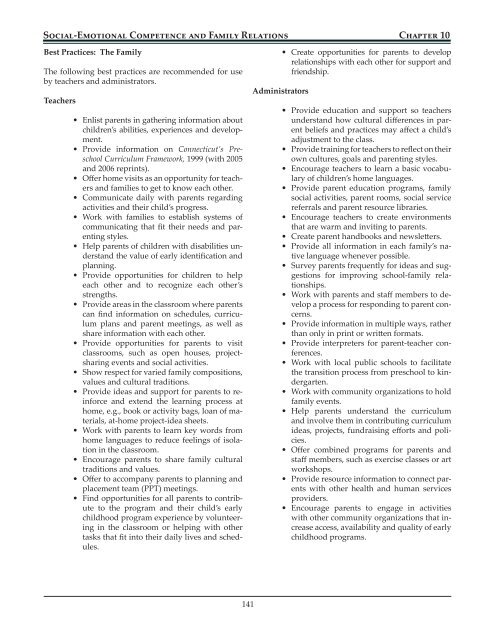Early Childhood - Connecticut State Department of Education
Early Childhood - Connecticut State Department of Education
Early Childhood - Connecticut State Department of Education
You also want an ePaper? Increase the reach of your titles
YUMPU automatically turns print PDFs into web optimized ePapers that Google loves.
Social-Emotional Competence and Family Relations Chapter 10<br />
Best Practices: The Family<br />
The following best practices are recommended for use<br />
by teachers and administrators.<br />
Teachers<br />
• Enlist parents in gathering information about<br />
children’s abilities, experiences and development.<br />
• Provide information on <strong>Connecticut</strong>’s Preschool<br />
Curriculum Framework, 1999 (with 2005<br />
and 2006 reprints).<br />
• Offer home visits as an opportunity for teachers<br />
and families to get to know each other.<br />
• Communicate daily with parents regarding<br />
activities and their child’s progress.<br />
• Work with families to establish systems <strong>of</strong><br />
communicating that fit their needs and parenting<br />
styles.<br />
• Help parents <strong>of</strong> children with disabilities understand<br />
the value <strong>of</strong> early identification and<br />
planning.<br />
• Provide opportunities for children to help<br />
each other and to recognize each other’s<br />
strengths.<br />
• Provide areas in the classroom where parents<br />
can find information on schedules, curriculum<br />
plans and parent meetings, as well as<br />
share information with each other.<br />
• Provide opportunities for parents to visit<br />
classrooms, such as open houses, projectsharing<br />
events and social activities.<br />
• Show respect for varied family compositions,<br />
values and cultural traditions.<br />
• Provide ideas and support for parents to reinforce<br />
and extend the learning process at<br />
home, e.g., book or activity bags, loan <strong>of</strong> materials,<br />
at-home project-idea sheets.<br />
• Work with parents to learn key words from<br />
home languages to reduce feelings <strong>of</strong> isolation<br />
in the classroom.<br />
• Encourage parents to share family cultural<br />
traditions and values.<br />
• Offer to accompany parents to planning and<br />
placement team (PPT) meetings.<br />
• Find opportunities for all parents to contribute<br />
to the program and their child’s early<br />
childhood program experience by volunteering<br />
in the classroom or helping with other<br />
tasks that fit into their daily lives and schedules.<br />
141<br />
Administrators<br />
• Create opportunities for parents to develop<br />
relationships with each other for support and<br />
friendship.<br />
• Provide education and support so teachers<br />
understand how cultural differences in parent<br />
beliefs and practices may affect a child’s<br />
adjustment to the class.<br />
• Provide training for teachers to reflect on their<br />
own cultures, goals and parenting styles.<br />
• Encourage teachers to learn a basic vocabulary<br />
<strong>of</strong> children’s home languages.<br />
• Provide parent education programs, family<br />
social activities, parent rooms, social service<br />
referrals and parent resource libraries.<br />
• Encourage teachers to create environments<br />
that are warm and inviting to parents.<br />
• Create parent handbooks and newsletters.<br />
• Provide all information in each family’s native<br />
language whenever possible.<br />
• Survey parents frequently for ideas and suggestions<br />
for improving school-family relationships.<br />
• Work with parents and staff members to develop<br />
a process for responding to parent concerns.<br />
• Provide information in multiple ways, rather<br />
than only in print or written formats.<br />
• Provide interpreters for parent-teacher conferences.<br />
• Work with local public schools to facilitate<br />
the transition process from preschool to kindergarten.<br />
• Work with community organizations to hold<br />
family events.<br />
• Help parents understand the curriculum<br />
and involve them in contributing curriculum<br />
ideas, projects, fundraising efforts and policies.<br />
• Offer combined programs for parents and<br />
staff members, such as exercise classes or art<br />
workshops.<br />
• Provide resource information to connect parents<br />
with other health and human services<br />
providers.<br />
• Encourage parents to engage in activities<br />
with other community organizations that increase<br />
access, availability and quality <strong>of</strong> early<br />
childhood programs.

















